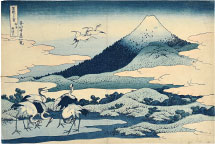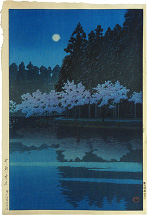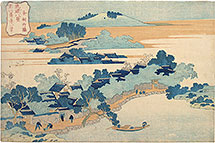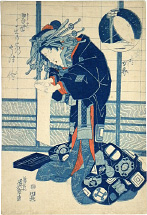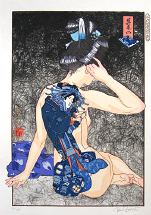
BLUE PRINT
Asia Week New York
September 8 - 18, 2011
Monday - Saturday, 11am - 5 pm
September 19 - November 6, 2011
Monday - Saturday, 11am - 5 pm
by appointment
New York Print Week
November 1st - 6th, 2011
public hours with extended weekend
11am - 5pm
online exhibition...
exhibition index...
An exhibition inspired simply by the color blue- a hue which actually played a pivotal role in the development of Japanese woodblock printmaking in the 19th century.
In the late 1820s a new imported blue pigment became more readily available and affordable to woodblock print publishers. This intense blue was developed in Berlin by a color manufacturer in the early 18th century, and had been sporadically imported to Japan as early as the 1780s, primarily for use by painters. The color was known as bero, a derivation from the Dutch Berlyns blaauw ('Berlin blue'); in English it is often called Prussian blue. Unlike the natural pigments previously used for print-making; this blue was strong, vibrant, and stable. While there may be examples where bero was used on woodblock prints in the 1820s, it was not widely utilized until circa 1830 when the costs decreased and the quantities increased (apparently as a result of competition between the Dutch and Chinese importers). By 1830 the production of the landscape series, 'Thirty-Six Views of Mt. Fuji' by Katsushika Hokusai (1760-1849) was underway, a landmark series which was initially advertised as aizuri-e ('all blue') series rendered in bero. At about the same time, a relatively unknown artist, Utagawa Hiroshige (1797-1858), began his landscape series, 'Fifty-three Stations of the Tokaido.' The inarguable success of these two ambitious projects essentially mark the advent of a new genre of ukiyo-e: landscape prints.
This exhibition begins an example of a rare aizuri-e from Hokusai's 'Thirty-Six Views of Mt Fuji', and an even more rare print from his 'Eight Views of Ryukyu' series in primarily blue palette. In addition to landscapes there are bijin prints, two by Keisai Eisen (1790-1848), one of the leading bijin-ga artists of the time who also produced landscapes utilizing the new blue pigment. In fact, there is scarce (if not unique) fan print by Eisen dated 1829 in the collection of the Brooklyn Museum of Art which is thought to be the earliest dateable aizuri-e. Into the 20th century with examples by leading artists such as Hashiguchi Goyo (1880-1921), Ito Shinsui (1898-1972), Kawase Hasui (1883-1957), Hiroshi Yoshida (1876-1950), Kobayakawa Kiyoshi (1896-1948) and Torii Kotondo (1900-1976), we can see how appealing and enduring the hue of blue continued to be. The exhibition concludes with the work of Paul Binnie (b. 1967), who recently created a bijin print in homage to Eisen and the aizuri-e, coming full circle back to the 'blue revolution'.
For an in-depth discussion on the history of the color blue and the importance of the Berlin blue pigment in the development of ukiyo-e see Henry D. Smith II, Hokusai and the Blue Revolution in Edo Prints; in Hokusai and His Age, John Carpenter, ed., 2005, pp. 235-269
Scholten Japanese Art, located at 145 West 58th Street, Suite 6D, is open Monday through Friday, and some Saturdays, 11am to 5pm, by appointment. To schedule a visit please call (212) 585-0474.
For the duration of the exhibition, September 8-18, the gallery will have general open hours (no appointments needed) Mon. - Sat., 11am to 5pm.
